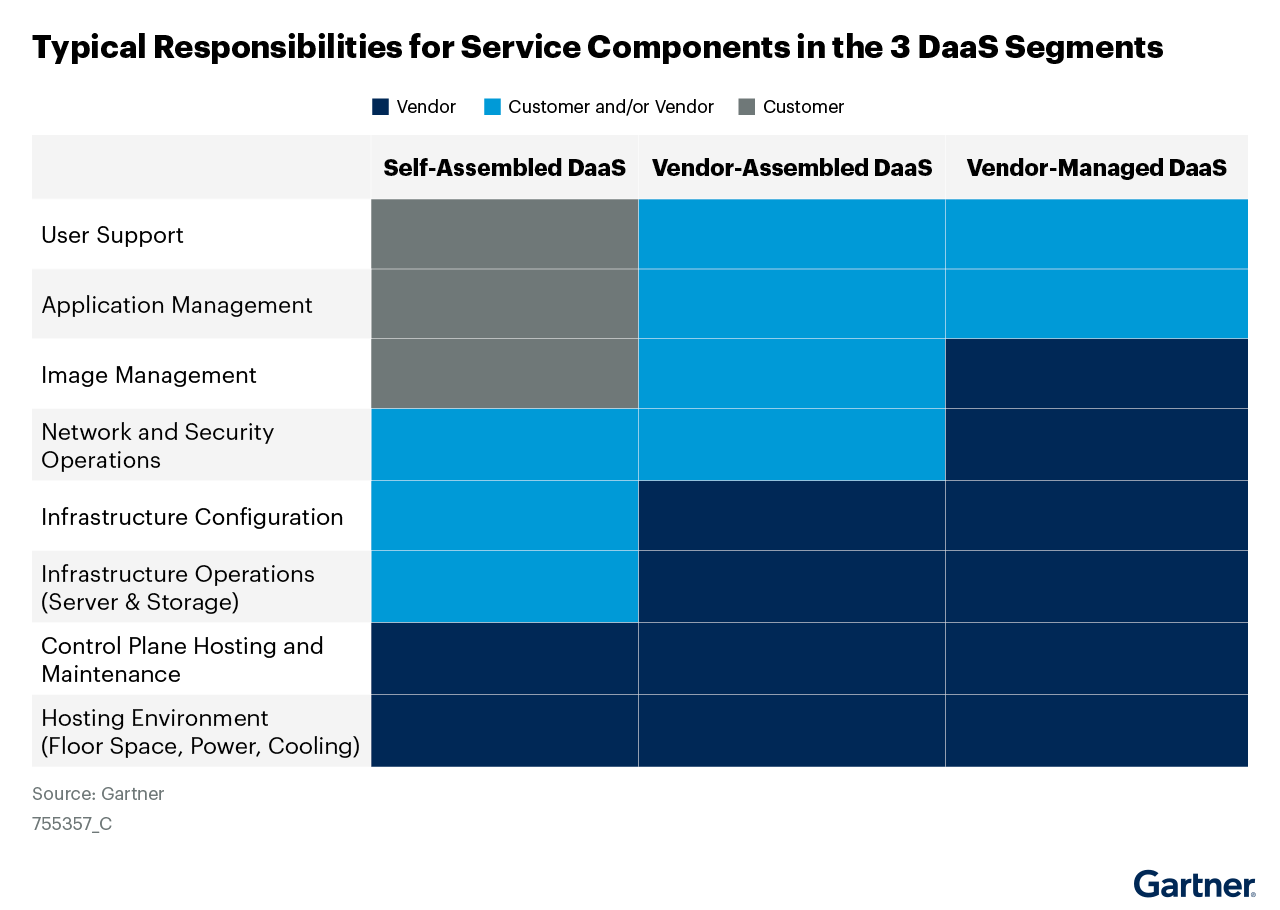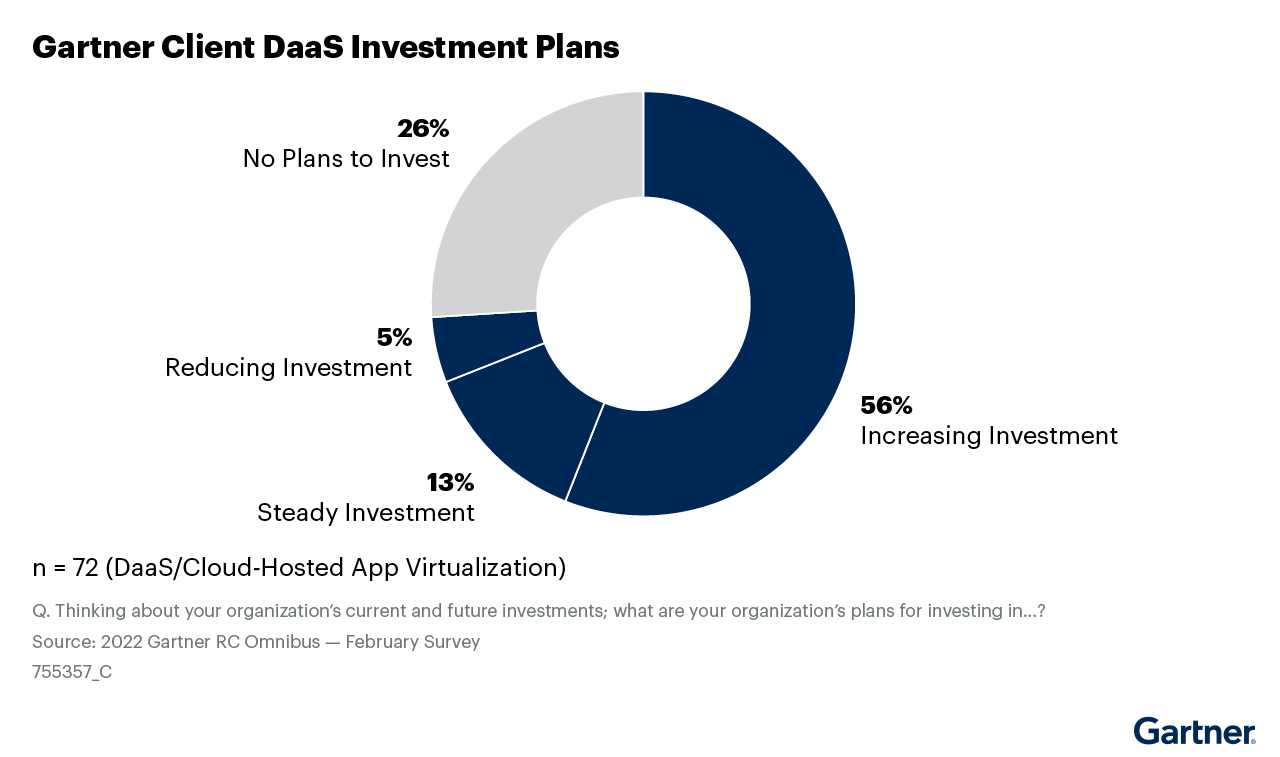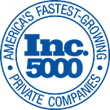"Fastest remote desktop I have ever used.” – G2.com 
2023 Gartner® Market Guide for Desktop as a Service
The rapid increase in remote and hybrid work, as well as the need for business continuity, has made DaaS a major priority for organizations. I&O leaders can use the assessment of the market segmentation and use cases for DaaS in this research to make better investment decisions.
Overview
Key Findings
-
Desktop as a service (DaaS) market spending grew by 22% in 2022 compared with 2021 and is forecast to grow by 19% in 2023 as I&O leaders continue to adopt DaaS to enable remote work.
-
The DaaS market has developed into three segments: self-assembled, vendor-assembled and vendor-managed.
-
Microsoft dominates the DaaS market due to license bundling, perceived network proximity with Microsoft 365 data and product terms that restrict which vendor’s clouds the Microsoft Windows versions of Microsoft 365 Applications can be installed.
Recommendations
I&O leaders responsible for digital workplace transformation and DaaS strategies should:
-
Identify the organizational fit for DaaS by assessing whether current (non-DaaS) end-user computing solutions can securely and cost-effectively enable hybrid and remote workstyles.
-
Shortlist appropriate DaaS vendors based on the services (e.g., graphics processing unit [GPU], compliance, support, regional availability, commercial terms) and rank them based on key features and how the service complements in-house IT skills.
-
Maximize improvements to digital employee experience by carefully balancing DaaS costs with performance.
By 2026, 80% of DaaS sales will be vendor-assembled or vendor-managed solutions compared with less than 20% in 2023.
Market Definition
Market Description
-
Self-assembled DaaS is where the client assembles a DaaS solution from components made available by the vendor. Clients would select and configure the cloud infrastructure, profile management technology and associated storage. Clients would be responsible for configuration and management of the user virtual machines. The vendor operates the client-selected components and provides management and updates of the infrastructure through the life of the service. This segment includes Microsoft Azure Virtual Desktop, Amazon WorkSpaces, Citrix Systems (DaaS) or VMware Horizon Cloud.
-
Vendor-assembled DaaS is where the vendor defines most of the solution. The client has less configuration work to perform and focuses on management of the user virtual machines. This segment includes Amazon WorkSpaces, ATSG(dinCloud), Windows 365, Workspot and others.
-
Vendor-managed DaaS is where the full service is managed and supported by the vendor. Managed DaaS vendors generally manage the virtual machine operating systems (i.e., patch and update the user’s Windows image) and in some cases provide user support. Vendors in this segment include systems integrators, managed service providers Dizzion, ATSG(dinCloud), Workspot and others (see Table 1 and Figure 1).
Table 1: DaaS Market Segment Organization Profiles
|
DaaS Market Segment
|
Organization Profile
|
|
Self-assembled DaaS |
|
|
Vendor-assembled DaaS |
|
|
Vendor-managed DaaS |
|
Figure 1: Typical Responsibilities for Service Components in the 3 DaaS Segments

Market Direction
Investment in DaaS is rising as clients seek to provide secure solutions that are less prone to cyberthreats. Fifty-five percent of clients told Gartner that they plan to increase spending in DaaS through 20241 (see Figure 2). The DaaS market is forecast to grow through 2026, but at significantly lower rates. The compound annual growth rate (CAGR) from 2022 to 2026 is forecast to be approximately 14%, compared with a CAGR of 59% between 2019 and 2022. Although DaaS is a significant market, by Gartner estimates of user volumes, it is less than 10% of the physical enterprise PC market.
Adoption of self-assembled DaaS services dominated the market in 2021 and 2022. We expect a shift toward adoption of vendor-assembled and vendor-managed DaaS in 2023 and beyond, driven by clients not wishing to have responsibility for operating DaaS infrastructures as well as net new clients that require vendor-managed solutions that reduce complexity and skills required. The shift toward vendor-assembled and vendor-managed DaaS is today inhibited by actual or perceived cost increases.
While the DaaS market continues to grow, we have observed some DaaS clients reducing their spend on DaaS and moving back to physical PCs. Five percent of clients said they planned to reduce spending in DaaS, so it remains a small proportion of DaaS deployments.1 Gartner clients cite moving from DaaS to physical PCs due to:
- Cost
- Difficulty optimizing real-time audio and video (RTAV), resulting in poor employee sentiment toward DaaS
- Complexity of operations, especially with self-assembled DaaS solutions
The selection of DaaS vendors through 2026 will increasingly be based on employee experience, alongside security and cost. Increased focus on data residency and security from DaaS vendors has and will continue to provide regulated clients with compliant DaaS solutions in more countries and regions. To date, we have seen financial services and public sector DaaS adoption focused in regions where sovereign clouds are available.
Figure 2: Gartner Client DaaS Investment Plans

The market remains primarily focused on use cases that involve securing access to desktops for a highly distributed or hybrid workforce. Third-party employees are a common use case, which is common for segments such as business process outsourcing or software development.
Market Analysis
Gartner clients are selecting self-assembled, vendor-assembled and vendor-managed DaaS based on the level of operational complexity balanced with cost. More organizations that have the skills to operate complex DaaS solutions are selecting vendor-assembled or vendor-managed solutions because this frees up those skilled resources to focus on delivering employee experience, automation and broader digital initiatives. Cost remains a key selection criteria for DaaS. Many clients have adopted multisession-based virtual machines to reduce costs. Clients must carefully assess the cost versus performance of all elements of DaaS operations before selecting a solution. Table 2 shows how prices vary based on the style of virtual desktop and whether the solution is self-assembled, vendor-assembled or vendor-managed.
Table 2: Negotiated Price Ranges per User per Month for DaaS
|
Specification
|
Self-Assembled
|
Vendor-Assembled
|
Vendor-Managed
|
|
Basic Multisession pooled Typical VM specification 8vCPU 32 GB RAM 64 GB Storage providing 2vCPU and 8GB Ram per user |
$15-25 |
$23-40 |
$38-50 |
|
Medium Single-session pooled Typically 4vCPU 16GB RAM 128GB Storage |
$30-50 |
$45-70 |
$50-90 |
|
High Performance Single-session persistent Typically 8vCPU 32GB RAM 256GB Storage |
$100-130 |
$100-175 |
$120-200 |
Source: Gartner (March 2023)
Market penetration of vendor-assembled DaaS solutions has increased in the previous 12 months and will continue to increase. This is driven by clients with limited skills to operate virtual desktop solutions, either on-premises or in the cloud, or it is driven by net new users for virtual desktops. Gartner clients often cite a desire to “get out of managing virtual desktops”; vendor-assembled and vendor-managed DaaS solutions are a good fit to help clients hit this priority.
This Market Guide lists 24 vendors; however, Microsoft is the dominant vendor (see Note 2). Gartner estimates that the Azure platform accounts for 90% of DaaS workloads, with Microsoft’s own offerings estimated to make up 60% of Azure’s DaaS workloads. Microsoft dominated DaaS adoption over the last three years because:
-
Many clients have a Microsoft-first approach for digital workplace software and services.
-
Microsoft benefited from adoption of Windows 10 and Windows 11 multisession, which is only available on Azure Virtual Desktop, either directly or via Microsoft partnerships with other vendors (including Citrix Systems, Parallels International, VMware and Workspot).
-
Third-party tools, which optimize operations and costs of a native Microsoft Azure Virtual Desktop deployment (e.g., Nerdio, HashiCorp [Terraform]), are available.
-
Managed service providers deliver DaaS using Azure as a platform.
-
The installation of Microsoft 365 Applications is possible on Azure but not on Alibaba, AWS or Google (see 3 Compliance Questions to Ask When Licensing Microsoft Windows and Office for VDI and DaaS).
-
Microsoft develops the Windows OS, the Azure platform, Microsoft 365 and Microsoft Intune, meaning their offerings can be integrated into a single vendor solution.
Ready to start a conversation?
We’re a team of trusted technology experts that work as an extension of company's IT team to help solve problems, deliver business outcomes and enable IT to be the heroes they are. From the first exploratory appointment to post-implementation support, we are always available to help.
Representative Vendors
The vendors listed in this Market Guide do not imply an exhaustive list. This section is intended to provide more understanding of the market and its offerings.
The following list of DaaS vendors provides a view of common vendors within the DaaS market (see Table 3). The list includes some regional and global vendors to allow organizations to assess how these providers can help with geographic coverage challenges. Vendors were selected based on awareness of them in the market and on discussion with Gartner clients that reference them (see Note 1).
Vendor Selection
Table 3: Representative Vendors in DaaS
|
Vendor |
HQ |
Product Name(s) |
|
Pune, India |
Accops DaaS |
|
|
Hangzhou, China |
Elastic Desktop Service |
|
|
Seattle, Washington |
Amazon WorkSpaces Amazon WorkSpaces Core Amazon AppStream 2.0 |
|
|
Mumbai, India |
Enterprise DaaS (Anunta Desktop360) DesktopReady |
|
|
Palo Alto, California |
Apporto |
|
|
New York |
ATSGOne DaaS |
|
|
Fort Lauderdale, Florida |
Citrix DaaS |
|
|
Merelbeke, Belgium |
Cloud Workstations |
|
|
Denver, Colorado |
Dizzion Managed DaaS |
|
|
King of Prussia, Pennsylvania |
Managed DaaS |
|
|
Shenzhen, China |
Workspace |
|
|
Anaheim Hills, California |
INFINITY Workspaces |
|
|
Miami, Florida |
itopia |
|
|
Waltham, Massachusetts |
Leostream |
|
|
Redmond, Washington |
Azure Virtual Desktop Windows 365 Business Windows 365 Enterprise Microsoft Dev Box |
|
|
San Jose, California |
Nutanix Frame |
|
|
Zurich, Switzerland |
oneclick VDI |
|
|
Washington, USA |
Parallels RAS |
|
|
Madrid, Spain |
SimpleCloud AECM SimpleCloud Animation SimpleCloud Education SimpleCloud Video Games |
|
|
Toronto, Canada |
Cloud Virtualization |
|
|
Ottawa, Canada |
Secure Virtual Desktops Carrier for Work |
|
|
Oceanport, New Jersey |
Digital Bunker |
Source: Gartner (March 2023)
Market Recommendations
To take the best advantage of DaaS, I&O leaders should:
- Identify the organizational fit for DaaS by assessing whether current end-user computing solutions can securely and cost-effectively enable hybrid and remote workstyles. Focusing on secure and distributed work will offer the best fit, especially where regulators demand enhanced levels of compliance.
- Shortlist appropriate DaaS vendors based on the services (e.g., GPU, compliance, support) they offer and rank them based on regional availability, key features and how the service complements their IT skills and commercial terms. There is a balance between cost, complexity and the skills available within an IT organization. For example, organizations with skills in operating on-premises VDI environments will be better suited to self-assembled DaaS solutions.
- Maximize improvements to digital employee experience by carefully balancing DaaS costs with performance. For example, don’t expect a high-performance information worker experience when specifying a virtual desktop to be 2 vCPU cores and 8GB of RAM. Provide a blend of virtual desktop specifications to meet the needs of all target use cases.
Evidence
1 2022 Gartner RC Omnibus — February Survey: The 2022 Gartner February Omnibus Survey was conducted online from 24 February through 9 March 2022. In total, 77 Research Circle members responded to the survey from North America (n = 40), EMEA (n = 28), APAC (n = 6) and Latin America (n = 3).
Note 1: Representative Vendor Selection
The representative vendor selection focus is on new as well as established DaaS service providers delivering services direct to end-user customers rather than to tooling or platform partners. This in no way diminishes the value of these other vendors within the ecosystem; rather, it highlights the fact that the B2C service contract will be between the service provider and the customer. Some of the vendors listed sell services directly and enable managed service providers (MSPs) and independent software vendors (ISVs), following a multichannel strategy. Gartner estimates the DaaS market has grown to well over 100 vendors but has picked 24 representative vendors that have low minimum term (12 months or less) and have been discussed in Gartner client inquiry.
Note 2: Gartner's Initial Market Coverage
This Market Guide provides Gartner’s initial coverage of the market and focuses on the market’s definition, rationale and dynamics.
© 2023 Gartner, Inc. and/or its affiliates. All rights reserved. Gartner is a registered trademark of Gartner, Inc. and its affiliates. This publication may not be reproduced or distributed in any form without Gartner's prior written permission. It consists of the opinions of Gartner's research organization, which should not be construed as statements of fact. While the information contained in this publication has been obtained from sources believed to be reliable, Gartner disclaims all warranties as to the accuracy, completeness or adequacy of such information. Although Gartner research may address legal and financial issues, Gartner does not provide legal or investment advice and its research should not be construed or used as such. Your access and use of this publication are governed by Gartner’s Usage Policy. Gartner prides itself on its reputation for independence and objectivity. Its research is produced independently by its research organization without input or influence from any third party. For further information, see "Guiding Principles on Independence and Objectivity." Gartner research may not be used as input into or for the training or development of generative artificial intelligence, machine learning, algorithms, software, or related technologies.
Your essential IT ally for the enterprise hybrid workforce.



Simplify and future-proof your technology footprint with Evolve IP







It's nearly impossible to stay on top of every change in technology. Partner with Evolve IP and gain the combined experience of hundreds of technologists, all acting as an extension of your IT team. Helping you do more with less.


